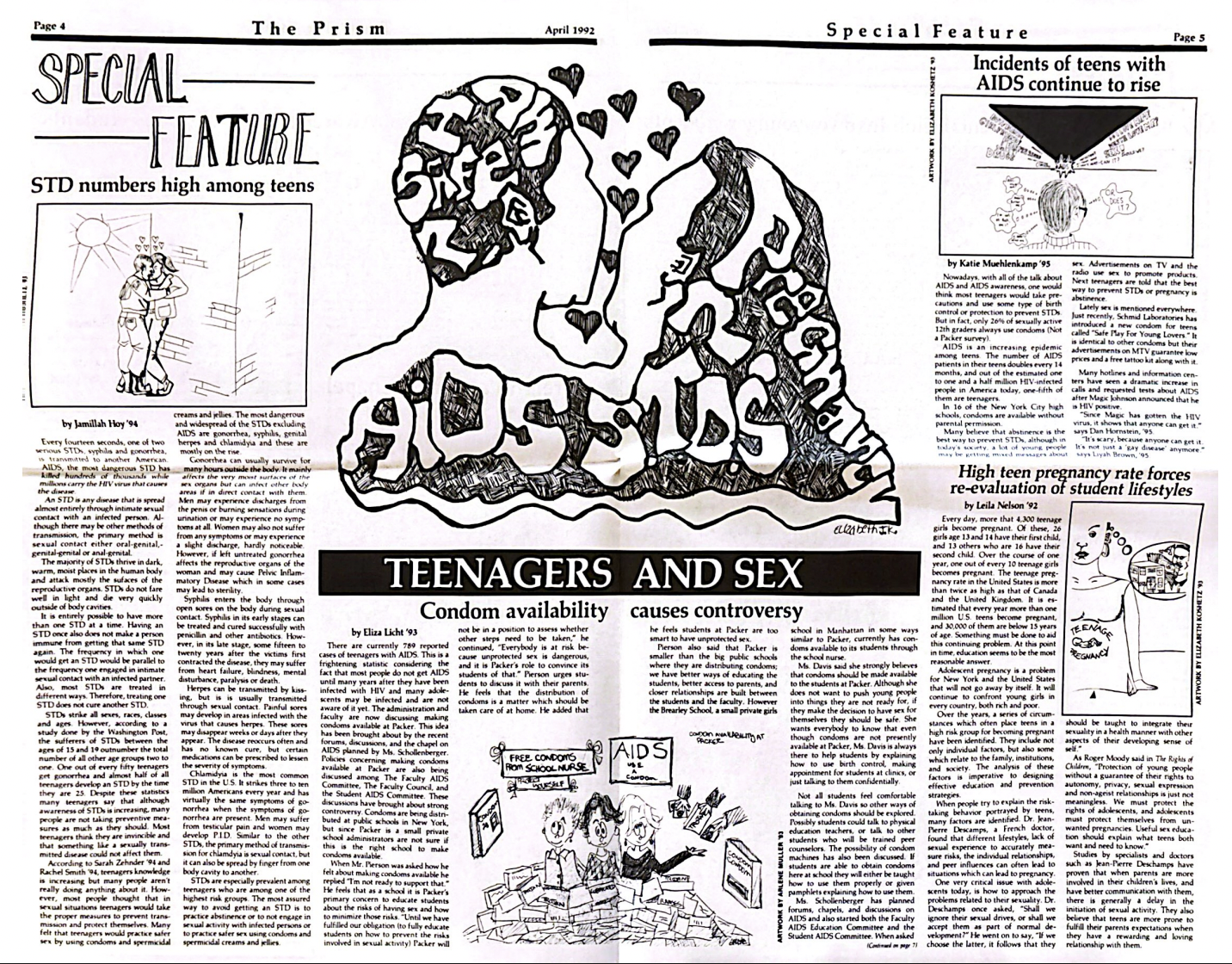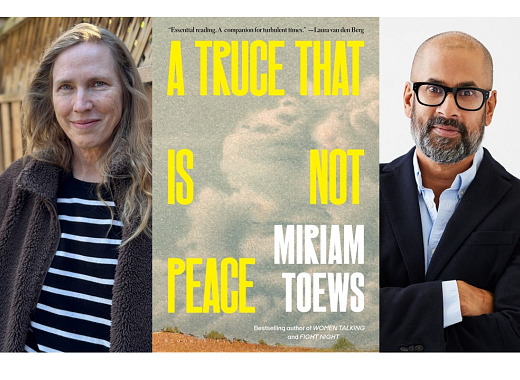The first and only time in my life that I heard about the AIDS epidemic was very briefly when my mom told me about the hospital where I was born. St. Vincent’s Hospital in Greenwich Village was the site of the first AIDS ward in New York City, and was run by nuns at a low cost for patients. When I discovered the AIDS/Brooklyn collection while digging through the finding aid at the Center for Brooklyn History, I was curious to learn more about this unfamiliar topic. I requested one box from this archival collection, and thus began my research.

Over the course of the past year, with the help of my teacher, Becca Zimmerman, in the Advanced Topics in Archival Research class at Packer, I uncovered a corner of history that had never quite been told before. One of the first sources I came across, a graphic novel called “Risky Stuff,” led me to question what I knew about the AIDS epidemic. The graphic novel featured teens inside of a school discussing various misconceptions of the disease and dispelling myths in an accessible way. I learned alongside these characters what AIDS is, how it is spread, and how to destigmatize what was commonly known as a “gay disease.” At the same time, I found myself wondering what teenagers, or people my age, were experiencing amidst this epidemic. What were they learning? How were they talking about it? What resources did they have? The treatment for AIDS, highly active antiretroviral therapy (HAART), wasn’t available until 1996, so education and awareness was the best means for “treating” the disease. Initially, I assumed that the majority of information they learned were coming from school, but as I dove deeper, I found that this was just the tip of the iceberg.
Two organizations that kept appearing and stood out to me were the AIDS Coalition to Unleash Power (ACT UP) and the Gay Men’s Health Crisis (GMHC). Although influential in AIDS activism during the ‘80s and ‘90s, there was very little mention of youth in their work, which led me to the New York City Board of Education. I ventured to the NYC Municipal Archives, where I found an edition of the Family Living and Sex Education curriculum from 1985. This curriculum dated back to the 1960s, when New York was adapting their education to fit the needs of their changing society. In 1985, this curriculum only included one bullet point about AIDS, even though this deadly disease had made its way across the whole country and frequented the front pages of newspapers. The Board of Education was responsible for every single student across all five boroughs of New York City, and for such a divisive topic like sex education, especially for this “gay disease,” it was nearly impossible to cater to everyone’s needs. While some parents found themselves constantly advocating for comprehensive sex education in schools, others spoke out against this and believed that it wasn’t the school’s place to get involved. Because of these opposing views, it wasn’t until 1987, while the death toll was still steadily increasing, that the BOE developed an AIDS supplement to this curriculum. This slow movement towards more AIDS education meant that communities became responsible and took matters into their own hands.


As both a Packer student and a Brooklyn resident, I found myself most interested in what was going on in Brooklyn. To provide myself with a foundation for this research, I read a few different books that helped me understand the culture in New York City and the history of the AIDS epidemic, but at this intersection, there was almost no mention of Brooklyn at all. This only became more surprising as I found one source, “Community Concern: AIDS in Brooklyn, A Report of a Public Hearing,” that revealed women and children in Brooklyn as primary victims of the epidemic. The transcripts from this public hearing demonstrate the lack of resources, both educational and medical, in the borough, as well as how strongly community members were fighting for more support.

Furthermore, I came across many different posters and pamphlets evidencing the community organizing that took place in Brooklyn. Organizations like the Brooklyn AIDS Task Force united community members and provided education, medical resources, support groups, and even a hotline to call. Other groups, like Women Fighting AIDS, Inc. created support groups for people to join together and simply discuss how AIDS was affecting their lives and families. Regardless of the city- or borough-wide resources (or lack thereof), people were finding ways to unite in the face of adversity.


Yet still, I couldn’t quite tell what was going on inside of schools or amongst teenagers. I now understood that the Board of Education or the city of New York were not going to provide me with the information that I needed. At this point, I came across the Youth Education Life Line (YELL), a student group functioning under ACT UP that distributed zines and organized events called “zaps” across the city. In these zaps, they positioned themselves outside of schools to pass out their zines, alongside condoms and other informational resources, and even sometimes organizing protests. They spoke up about the lack of comprehensive sex education inside of schools, and filled this gap.

Next, I turned to what I knew best: my own school. The Packer Collegiate Institute archival collection is the biggest one at the Center for Brooklyn History, and I was finally able to see more of a student and teacher perspective. When scouring our yearbooks from the 1980s and 1990s, I came across the AIDS Awareness Club that ran from 1993-1997. Led by a majority female group of students, I tracked down some of these alumni with the help of our Director of Alumni, and was able to interview two of them. Jess Levey and Natalie Sopic were both active members of the club and described to me what role they played in their community during such a critical time. The club fought to destigmatize AIDS in the school, educate their peers in order to prevent spread, organized fundraising events, and collaborated with faculty.

In addition to conducting oral history interviews with alumni, I was lucky enough to speak to two former Packer health and physical education teachers. George Boutis and Dorothy Gurreri both worked at Packer for decades, developing health curricula and classes and adapting them to the needs of students. They found students receptive to their approach, which was based on building connections and having conversations. Nevertheless, it was difficult for the school and teachers to fulfill everyone’s wishes, especially the contrasting ones of parents. While they tried to resolve this all while providing students with up-to-date information on AIDS and sex education, students were doing the same for each other. Outside of the club, the student-run newspaper, The Prism, frequently published articles discussing this topic. Various editions from the early 1990s discussed condom distribution in schools, the underestimated prevalence of AIDS amongst teenagers, and shared that students and faculty collaborated on creating a health forum to answer questions.

During the HIV/AIDS epidemic, members of school communities in Brooklyn took action in order to enact change within the schools and ultimately large-scale, institutional change. Brooklynites witnessed their disparities in resources with Manhattanites and took matters into their own hands to pressure figures of authority for support and educated amongst themselves. Parents, teachers, and students in particular witnessed firsthand the detrimental impact of the disease in schools, as well as the lack of response and support offered. They joined forces to advocate for more comprehensive sex and AIDS education, normalizing conversations surrounding previously taboo topics. When the Board of Education was slow in curriculum and policy development, activists bypassed these systems to provide youth with valuable and timely information. This disease permeated into all aspects of American culture, shaping the gay community in particular as a high-risk group and primary advocates. Despite the many advances socially and scientifically to combat AIDS, the disease remains a reality for many worldwide. Deaths by AIDS decrease yearly, but the most recent data shows that in 2022, about 20,000 people with HIV/AIDS passed away. In addition, all over the country, students’ current access to sex education is at risk. In today’s political climate, under the current presidential administration, governmentally provided education is highly debated, especially when it comes to “controversial” topics like sex, drugs, and healthcare. Instead of relying solely on curricula provided, students and teachers alike should draw upon their predecessors and their subversive educational efforts. They need to be the people again to fight for resources in classrooms and outside even while the government fights their way into the classroom at the same time. The same way that students spoke up for their access to accurate and comprehensive information decades ago, we should be now. Student advocacy is immeasurably valuable and does not have to be controlled through systems of checks and balances. Author and educator bell hooks said that “the classroom remains the most radical space of possibility,” and this radical space cannot be underestimated in its power of social activism.
This blog post reflects the opinions of the author and does not necessarily represent the views of Brooklyn Public Library.
Post a Comment
While BPL encourages an open forum, posts and comments are moderated by library staff. BPL reserves the right, within its sole discretion, not to post and to remove submissions or comments that are unlawful or violate this policy. While comments will not be edited by BPL personnel, a comment may be deleted if it violates our comment policy.
eNews Signup
Get the latest updates from BPL and be the first to know about new programs, author talks, exciting events and opportunities to support your local library.







